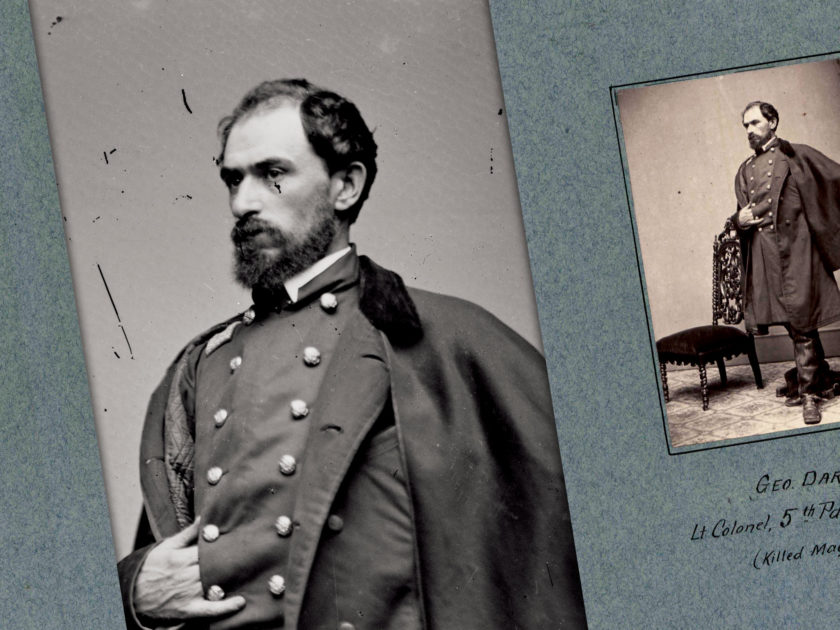By Kurt Luther
In my first “Photo Sleuth” column in 2015, I wrote about the power of combining perseverance and luck. After years of fruitless searching for photos of my Civil War ancestors, I had stumbled across a wartime carte de visite of my great-great-great granduncle, Cpl. Oliver Croxton, at a museum exhibit. Twenty-five columns later, in this issue of Military Images, I return to the same theme of serendipity and persistence. This time, my research allowed me to identify an unknown officer’s portrait in the Library of Congress.
The digitized collections of the Library of Congress are one of my favorite “hunting grounds” for Civil War photo sleuthing. These photos represent some of the most impressive—and most-viewed—examples of Civil War portraiture, so I am always motivated by the possibility of uncovering new information about them. There are also plenty of “targets” for an investigation. A keyword search for “unidentified” within the Civil War holdings of the Library’s Prints & Photographs Online Catalog yields more than 1,700 unknown photos.

One portrait among these has long caught my attention—a glass negative showing an unidentified Union officer in a striking martial pose. One of his arms displays the Napoleonic hand-in-waistcoat gesture, while his other arm is akimbo beneath an overcoat. The officer’s distinctive visage features piercing eyes, thinning hair, a short beard and mustache, and a prominent nose. He wears a field-grade officer’s frock, but the insignia on the shoulder straps is hidden by the camera angle and the overcoat. A pair of muddy boots with spurs completes the look.
The identity of the photographer is also unknown, though the studio’s decor included an ornate high-backed chair, a column, a curtain and patterned flooring. Aside from these modest clues and the soldier’s distinctive face, the photo offered few leads, such as a location, a regiment or branch of service, or even a specific rank.
Not surprisingly, my early attempts to discover the name of this officer proved unsuccessful. Reverse image searches from Google and TinEye turned up empty. The face recognition technology of CivilWarPhotoSleuth.com, which often helps in cases like this where an unusual face is the primary clue, returned no promising results. Facing a dead end, all I could do was repeat these searches from time to time. Nothing came of them.
Lucky for me, a major Civil War digitization project was underway that would eventually get me unstuck. In the Autumn 2017 edition of MI, Editor and Publisher Ron Coddington wrote a story about Gen. Samuel Crocker Lawrence, a Civil War veteran who amassed a collection of nearly 4,000 Civil War photos. This collection is now housed in the Medford Historical Society and Museum (MHSM) in Massachusetts. Coddington’s article concludes by noting that a digitization project was underway to make the entire collection available online. A September 2019 edition of the MHSM’s newsletter provided an update. According to MHSM Board Member Jay Stott, the collection was fully digitized in late 2019, and is believed the fifth-largest collection of Civil War period photos in the world.

However, this remarkable achievement escaped my notice until mid-2020, when a Facebook post about the MHSM collection by Civil War collector Ken Turner caught my attention. I paged through the MHSM’s online gallery for the first time and was astonished by the quality and rarity of the many wartime soldier portraits. As I neared the final pages of the gallery, however, my eyes locked on a familiar image. It was the unidentified Union officer! He wore the same overcoat, mud-spattered boots, and martial pose. The view appeared to be identical, though the MHSM version was a print. There was just one other notable difference: the MHSM version was identified as Lt. Col. George Dare, 5th Pennsylvania Reserves.
George Dare was born in Pennsylvania in 1836. The 1860 U.S. Census shows him working as a storekeeper in Franklin Township, Huntingdon County, Pa. He and his wife, Nannie, had recently married and lived in a boarding house. When war erupted the following year, Dare joined the 5th Pennsylvania Reserves (34th Pennsylvania Infantry) as captain of Company I. He was quickly appointed the regiment’s major and promoted to lieutenant colonel a year later. At the Battle of Fredericksburg, the commander of the Pennsylvania Reserves, Brig. Gen. Conrad F. Jackson, was killed, and the regiment’s colonel, Joseph W. Fisher, replaced him. Dare, wounded during the same battle, became the new commander of the 5th. He led the regiment at Gettysburg and into Virginia. On May 6, 1864, at the Battle of the Wilderness, Dare was “mortally wounded and died in camp during the night,” according to Bates’ History of Pennsylvania Volunteers. Just over a month later, Nannie Dare filed for a widow’s pension to support herself and her three young children.

Was Col. Dare the mystery officer pictured in the unidentified Library of Congress negative? I was hopeful, but cautious. The few visual clues available, such as the field officer’s frock, matched Dare’s biography, but the MHSM photo could be misidentified. Indeed, Jay Stott, the MHSM Board Member, warned that the collection’s “notes and captions are sometimes cryptic, misleading, or wrong.” To verify the ID, I searched for additional photos of George Dare, now that I had a name to work with. In the U.S. Army Military History Institute’s MOLLUS-Mass collection, I found some strong confirmatory evidence—a view that was also identified as Dare, and nearly identical to the MHSM photo.
I excitedly shared my findings with Micah Messenheimer, Curator of Photographs for the Library of Congress’s Prints and Photographs Division, who reviewed all three photos. Messenheimer found that the MHSM portrait identified as Dare is actually a print from the Library of Congress negative, based on the identical blemishes at the bottom edge of both views. In contrast, he found that the MOLLUS print is a slight variant from the same sitting, as a bit more of the column along the right edge is visible. “It is a striking portrait and it will be a great benefit to have a name attached to the officer,” he concluded.
Shortly after, the Library of Congress updated the mystery officer’s photo caption: “Lieutenant Colonel George Dare, 34th Pennsylvania Infantry.” Thanks to a combination of luck, perseverance, and the diligent efforts of archivists and fellow collectors, a soldier’s photo in the Library of Congress was unknown no more.
Kurt Luther is an associate professor of computer science and, by courtesy, history at Virginia Tech. He is the creator of Civil War Photo Sleuth, a free website that combines face recognition technology and community to identify Civil War portraits. He is an MI Senior Editor.
LEARN MORE about Military Images, America’s only magazine dedicated to showcasing, interpreting and preserving Civil War portrait photography.
VISIT OUR STORE to subscribe, renew a subscription, and more

